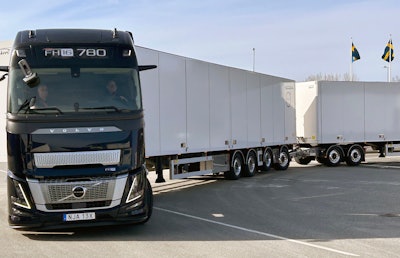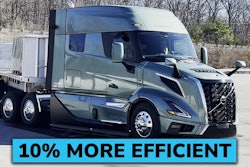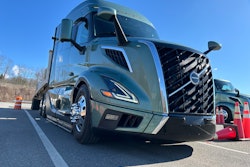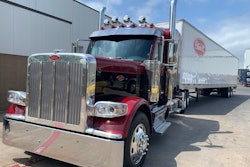
Back before regulators became enamored with batteries, efficiency was the big green play: aerodynamic fairings, wheel covers, trailer skirts, trailer tail pieces and nose cones – trucking efficiency and chasing MPGs used to be an aftermarket bonanza. Now much if it is standard, at least some of the pieces that were able to hang around are.
Then came light-weighting: tucking in aluminum wherever it made sense and spec'ing an 11-liter or 13-liter engine because they made sufficient power for most applications. Gone were the days of max power at all costs. I think they called that right-sizing.
Light-weighting helped drive Volvo's 16-liter out of the North American market in 2017, but across the Atlantic Volvo this year unveiled an even larger engine. But make no mistake; it's all about efficiency.
The D17 is the largest and most powerful diesel engine Volvo's ever put in a truck. That's fitting because I was able to drive the D17 diesel in Sweden recently and it was bolted to the largest, heaviest and longest rig I've driven in my life.
Available in three versions (600 hp, 700 hp and 780 hp), these engines grip the asphalt with 2,200, 2,500 and 2,800 lb-ft of torque.
This 17-liter diesel engine utilizes a dual-stage turbocharger and heavy-duty steel wave pistons to maximize power density, and a common rail injection system for high fuel efficiency and low exhaust emissions.
So how is this monster an efficiency play? Sweden late last year implemented new length and weight restrictions for heavy trucks, allowing a combination of trailers totaling 113 feet in length and up to 74 tonnes (about 163,000 pounds) on select highways. The short version: one really huge truck can move twice the freight of a normal one, according to Volvo Trucks Director of Environment and Innovation Lars Mårtensson, while producing 27% fewer emissions.
Fewer trucks means fewer accidents and less road congestion. Not only are there tailpipe benefits, there's backdoor benefits, too.
In a world awestruck by zero emissions, where does fewer emissions fit in? Right here and right now, according to Mårtensson.
While battery electric and hydrogen are very much the ways of the future (probably), more efficient diesel engines – and more efficient distribution methods like those unlocked in parts of Sweden totaling about 3,000 miles – can be deployed more immediately with little to no infrastructure buildout.
The D17 engine is certified to run on vegetable-oil based biofuel and the 700 hp version is also certified to run on 100% biodiesel, Mårtensson said.
The D17 for sure makes power. With 780 hp, I drug around 81.5 tons like it wasn't even back there, and that included climbing double-digit grades. Much like we've seen stateside with smaller displacement engines making comparable power to those with a larger bore, the D17 makes more power than the D16, and with fewer emissions.
It's also incredibly quiet, especially considering that it's in Volvo's FH16 cabover.
Will we ever see this engine in North America? Of course not. That's my guess/opinion, not anything Volvo told me. There's just no regulatory support for it. Off-interstate weight restrictions vary by a lot state-to-state, and it would take a harmonized effort at the state level to execute what Sweden has done. The ironic part is that many state roads couldn't support that kind of weight anyway.
So what's the point of this huge engine? If nothing else, it clearly demonstrates there are options that get us closer to greener transportation, and those options include the use of more conventional means that use existing and mature infrastructure, and are supported by a traditional and tested business model.
As Kermit sang, "It's not that easy being green," but it doesn't have to be painful and chaotic. Are zero emissions 30 years from now, and all the upheaval that comes with it, really better than a more stable progression of reduced emissions (and improved freight efficiency) over the next 30 years?
Maybe if we pumped the billions of dollars currently earmarked for EVs into highway and interstate infrastructure (road and bridge) improvement, we could unlock a network for road trains like Sweden and many other countries have. The roughly 3,100 miles Sweden approved last year is slightly longer than the distance from Los Angeles to New York. Talk about some incredible potential.










